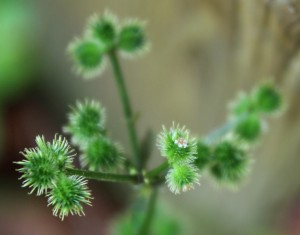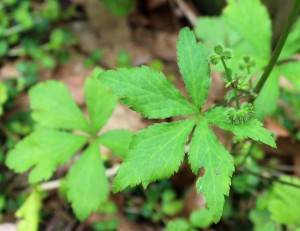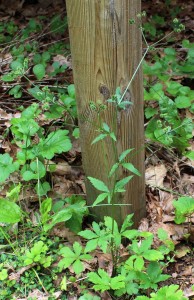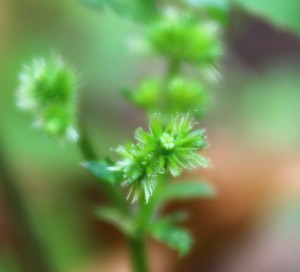Flowers aren’t the first thing you’ll notice about black snakeroot, but the spiny capsules that hold the tiny flowers are a little more eye-catching.

As far as why this plant is called snakeroot is a guess, but it probably has something to do with folk medicine where the leaves may have been used to poultice snakebite wounds.
A few plants seem to go by the common name of “Black Snakeroot” and the one photographed here is Canadian Blacksnakeroot. (Photos taken 6 July 2015. Click on a photo for a larger image.)
Canadian Blacksnakeroot, Sanicula canadensis, also known as Black Sanicle, has palmate leaves that are slightly deceiving.
What at first appears to be five leaflets is actually three leaflets having the outer two deeply cleft. Related species may look like they have seven leaflets while they really have five due to the shape of the outer leaflets.

This particular woodland herbaceous plant is growing in an open grassy area at the edge of the oak forest. Shade is where I’ve seen this plant before — along walkways, lanes and trails in wooded areas.

Fruit is a spiny capsule that has a way of sticking to socks, boot laces, jeans and animal fur to be deposited at random locations some distance from the mother plant. What a great survival strategy for this member of the Parsley Family!
Each capsule contains two seeds for starting the next generation.
Standing a few inches to over a foot in the air, the spiny fruits stick out just waiting for someone to brush by.
Close-up views show hooks on the ends of the spines for easy grabbing of fur and snagging of socks.

Flowers are really little and easily missed. Look at the top of a spiny capsule to see a tiny white flower with brown stamens. Flowering occurs in early to mid-summer in Central PA.
If you’ve ever taken a hike in the woods or played around the creek as a kid, you’ve probably picked up a few of the seed capsules unintentionally. The next time you experience the pokey seed carriers personally, you’ll know they were from a Black Snakeroot plant.